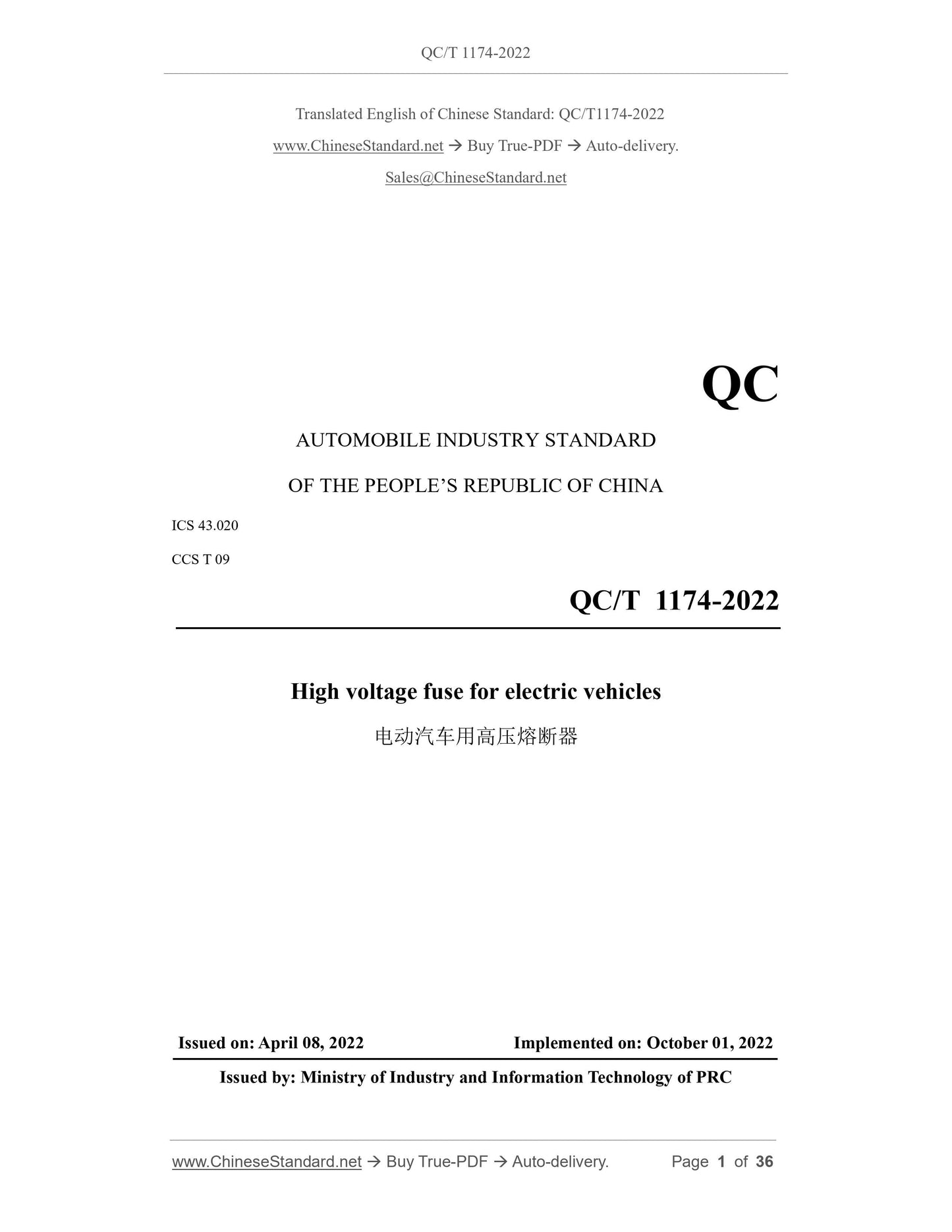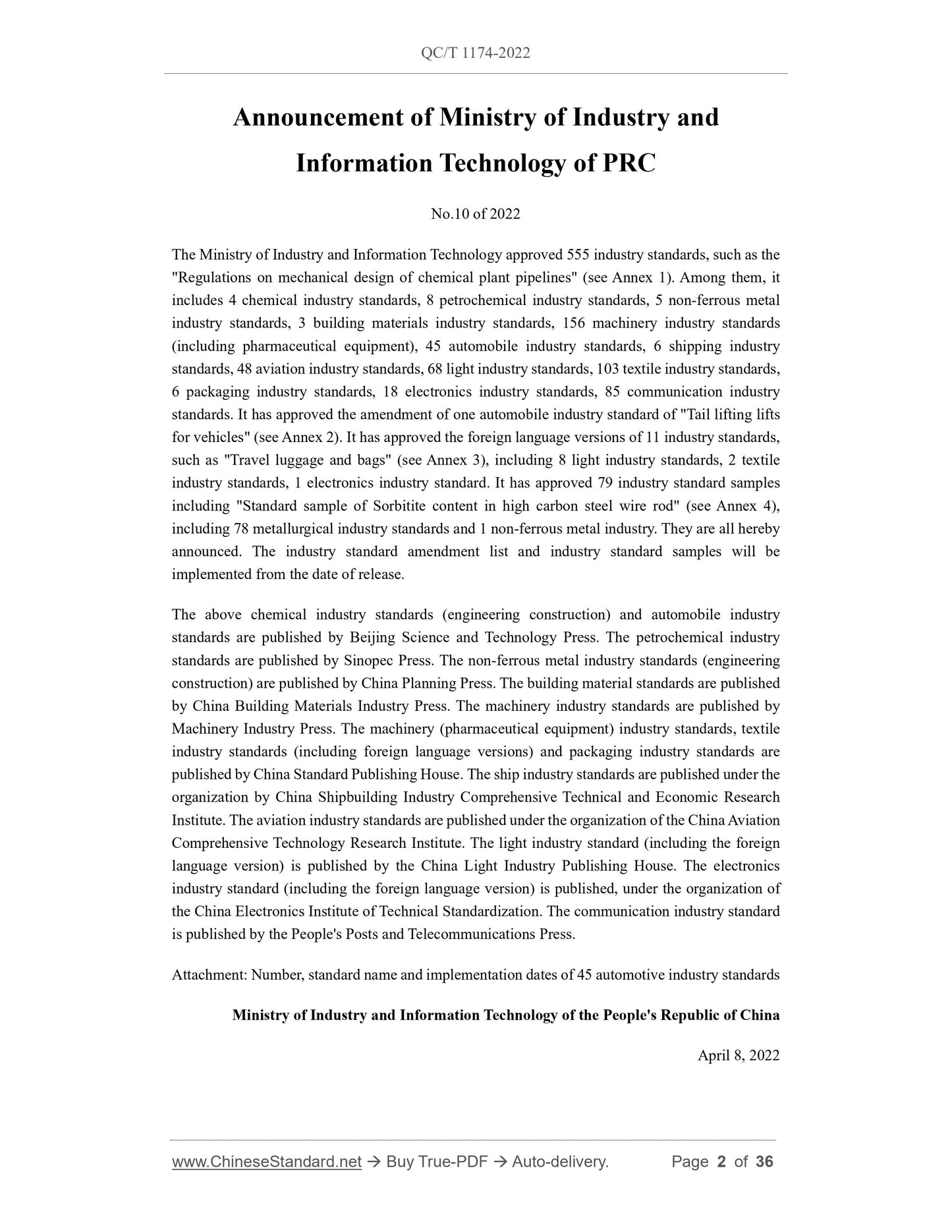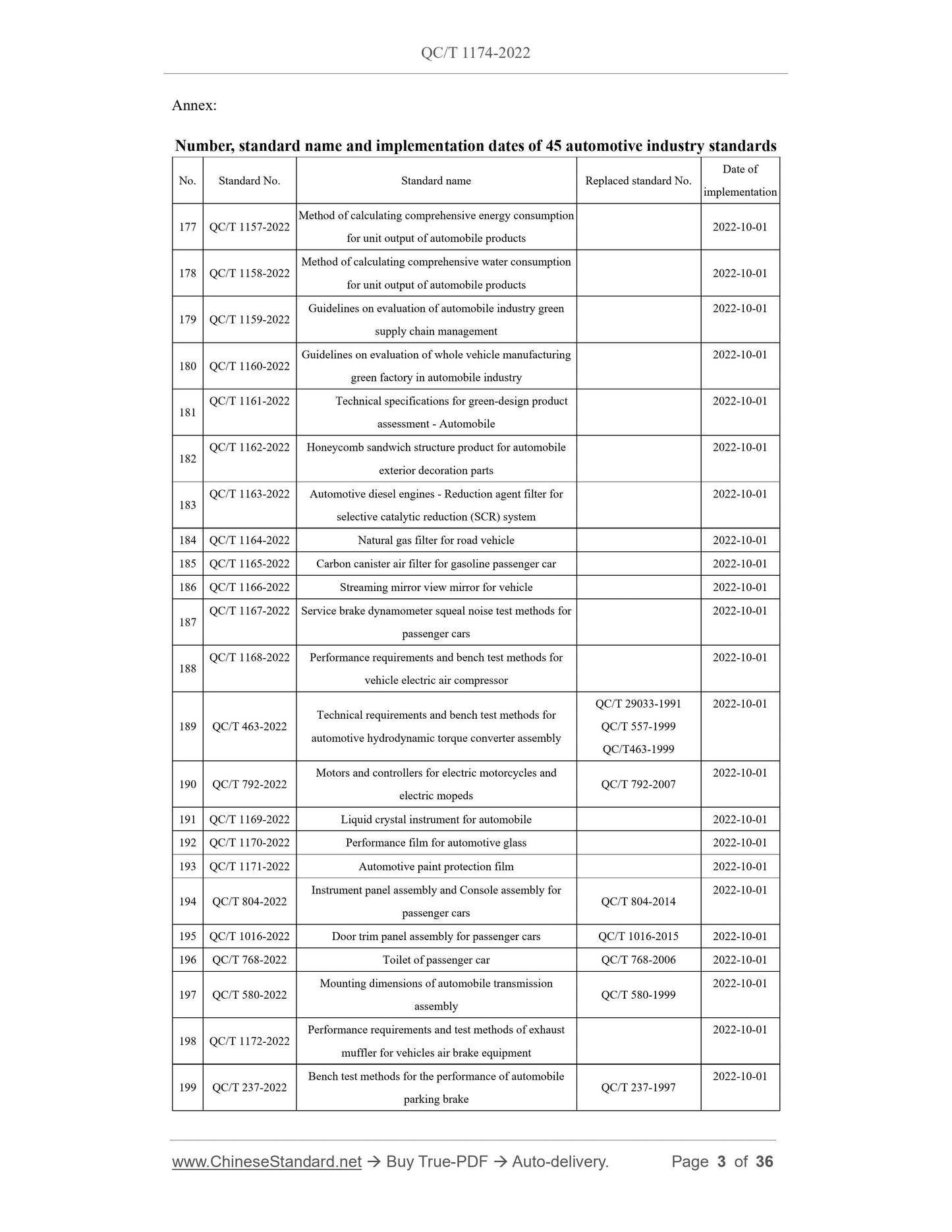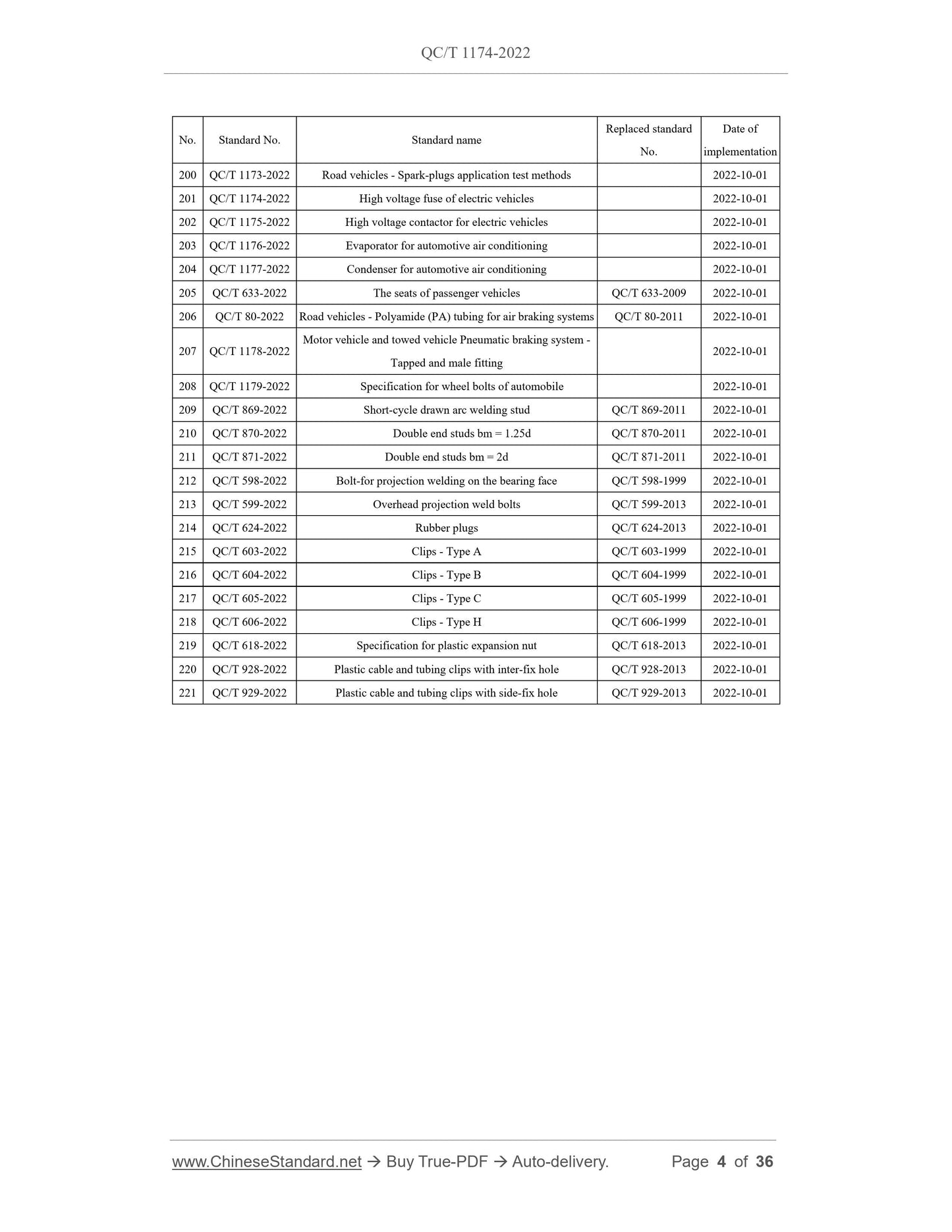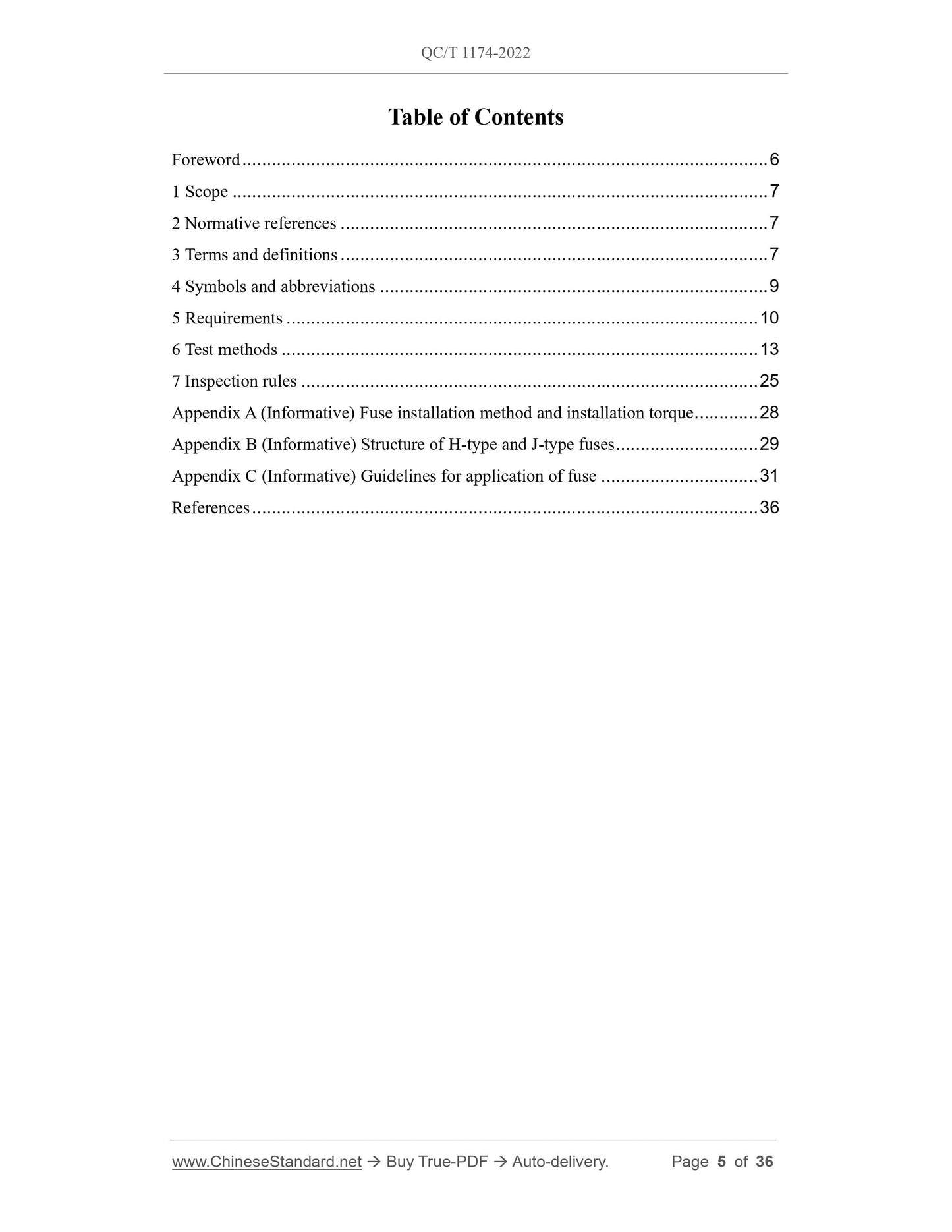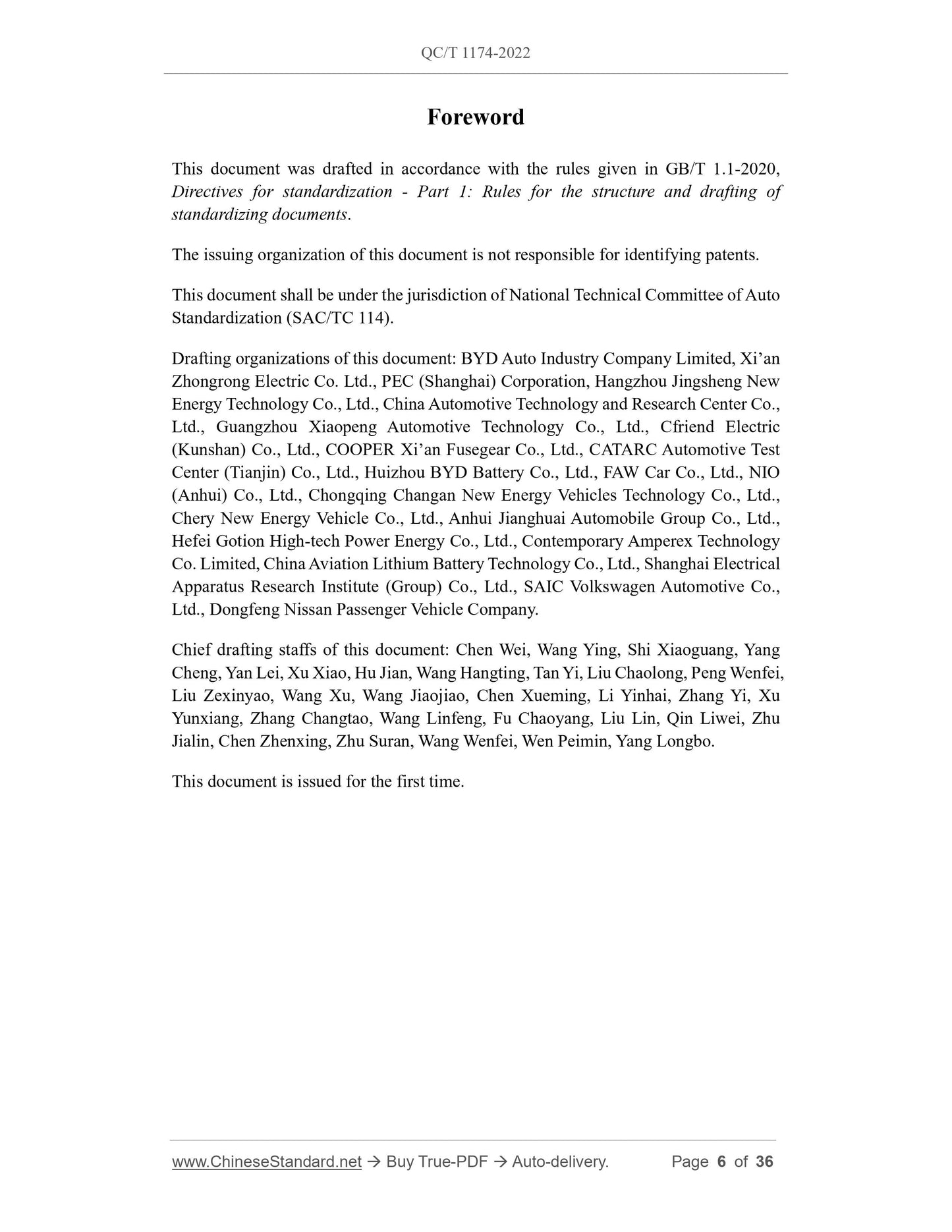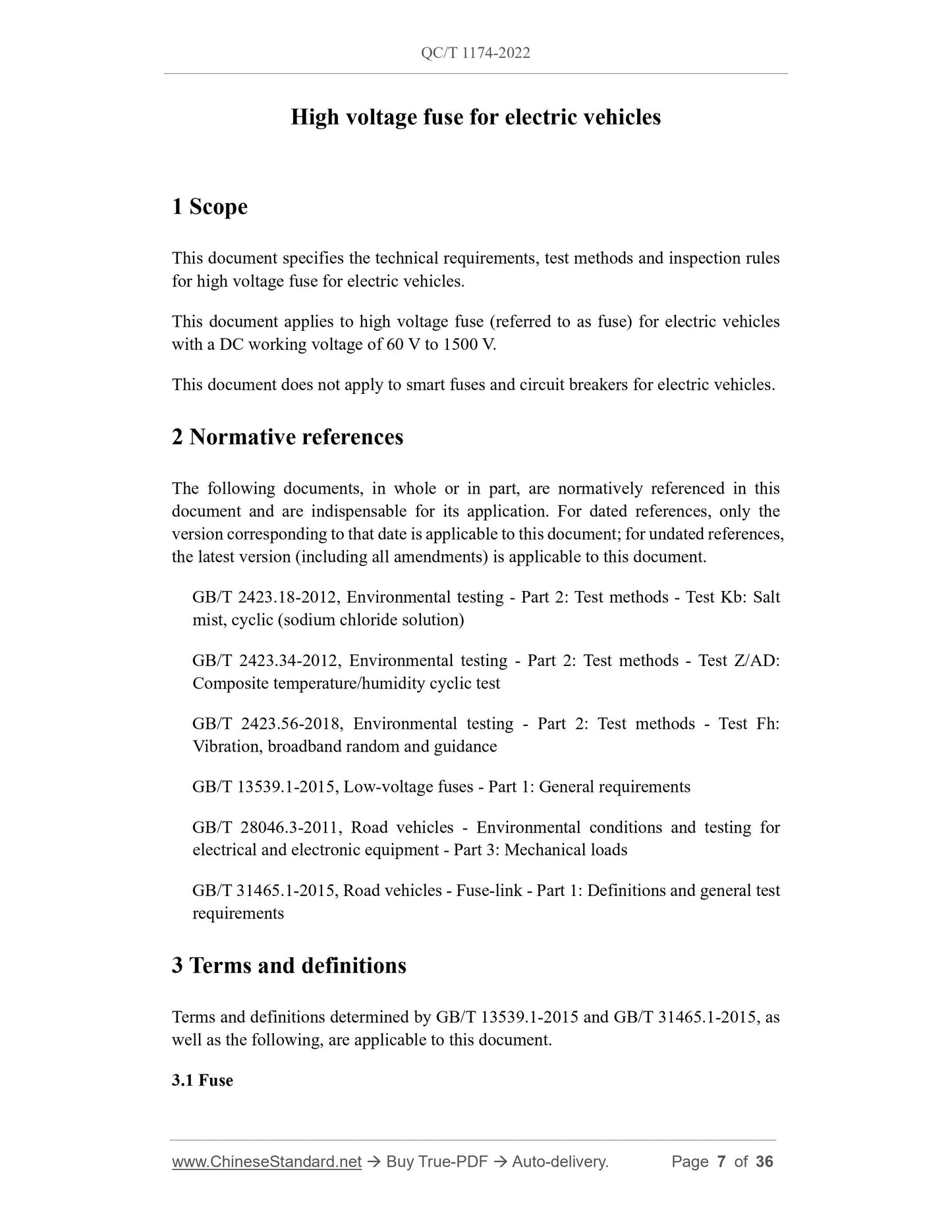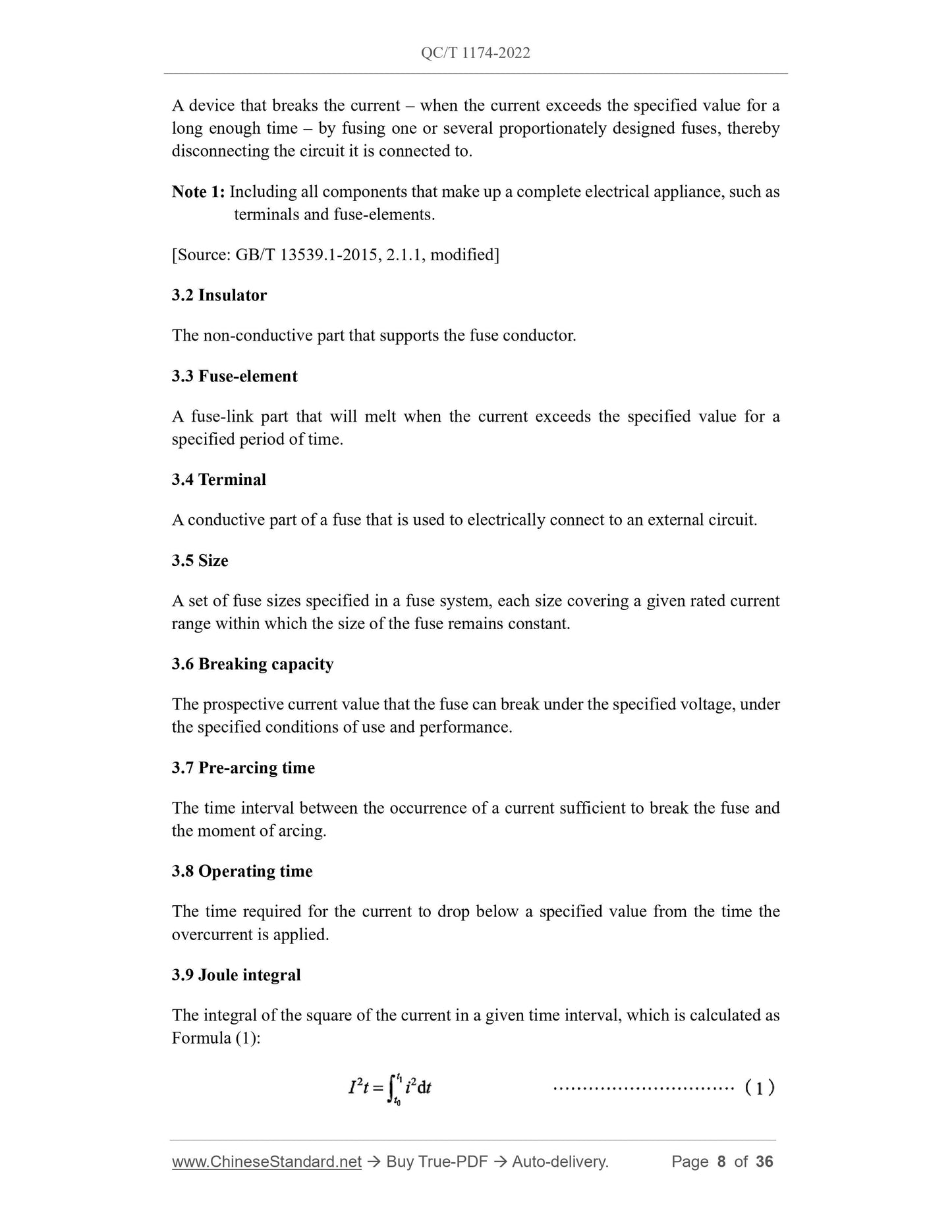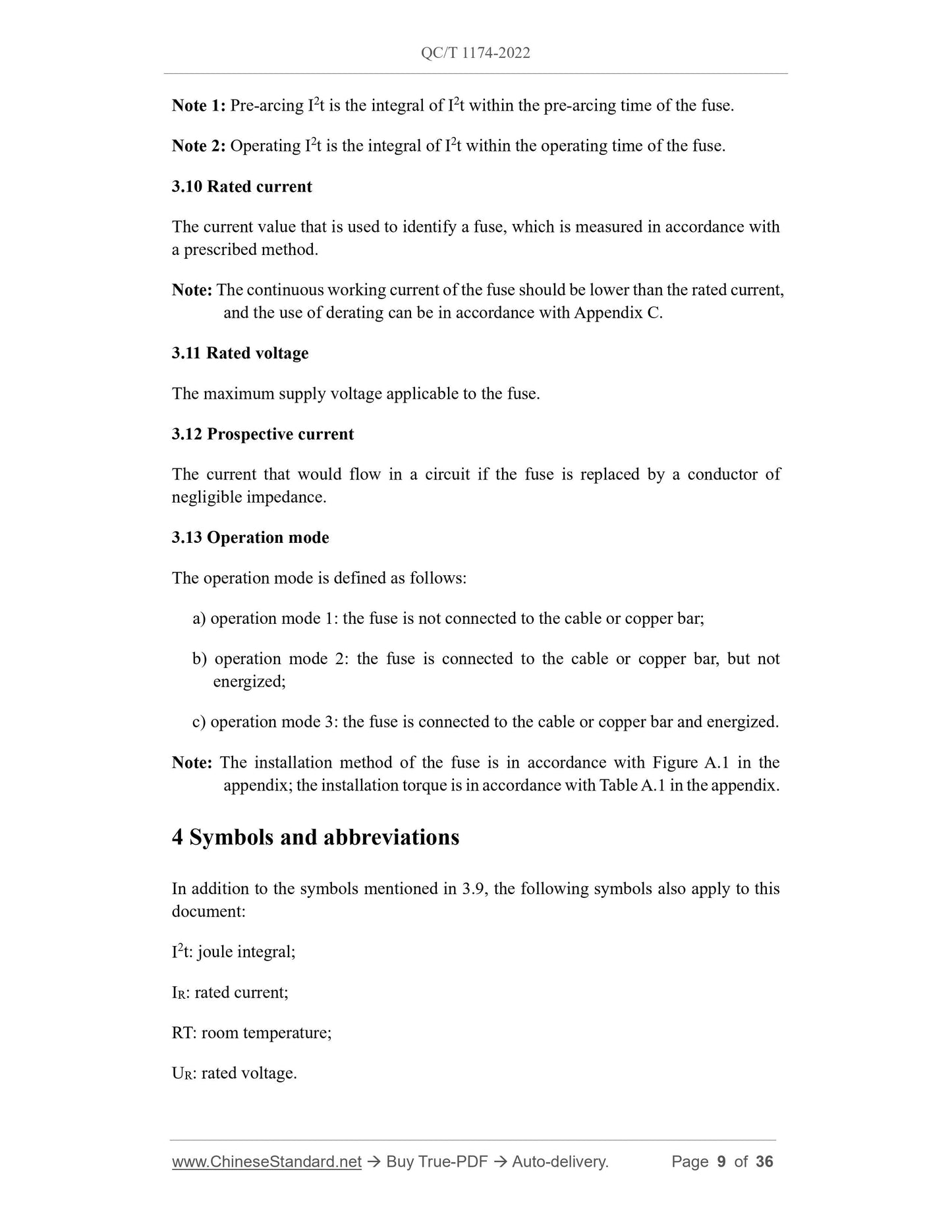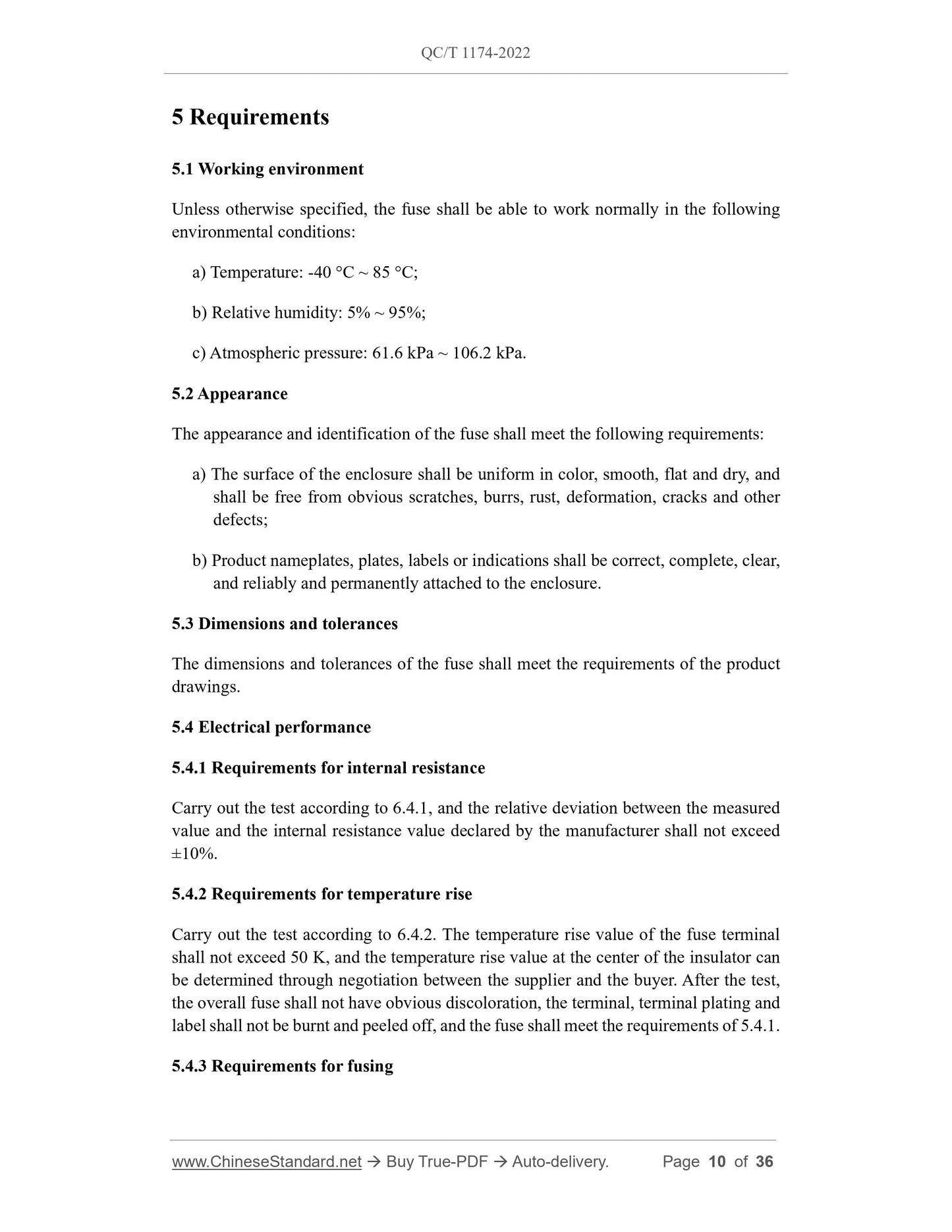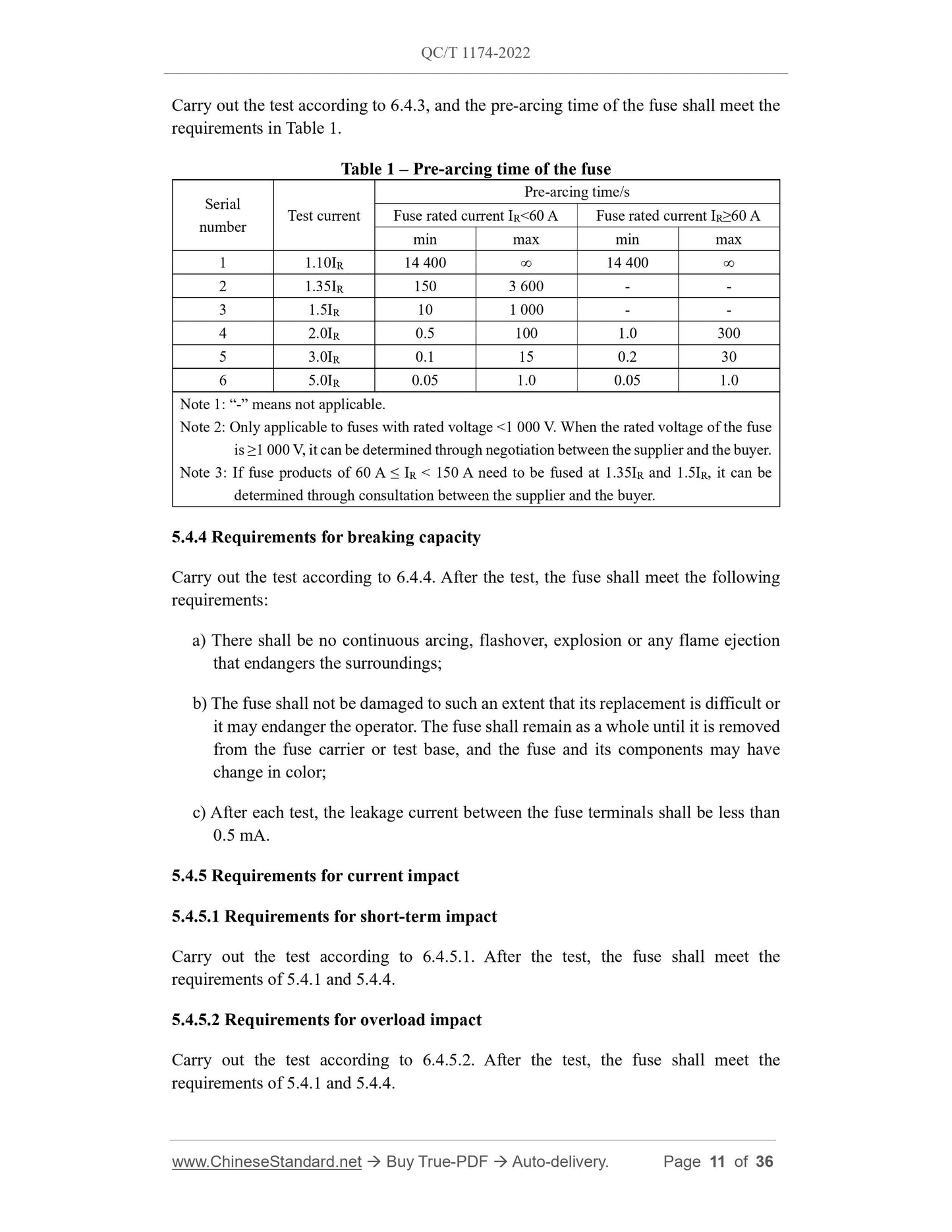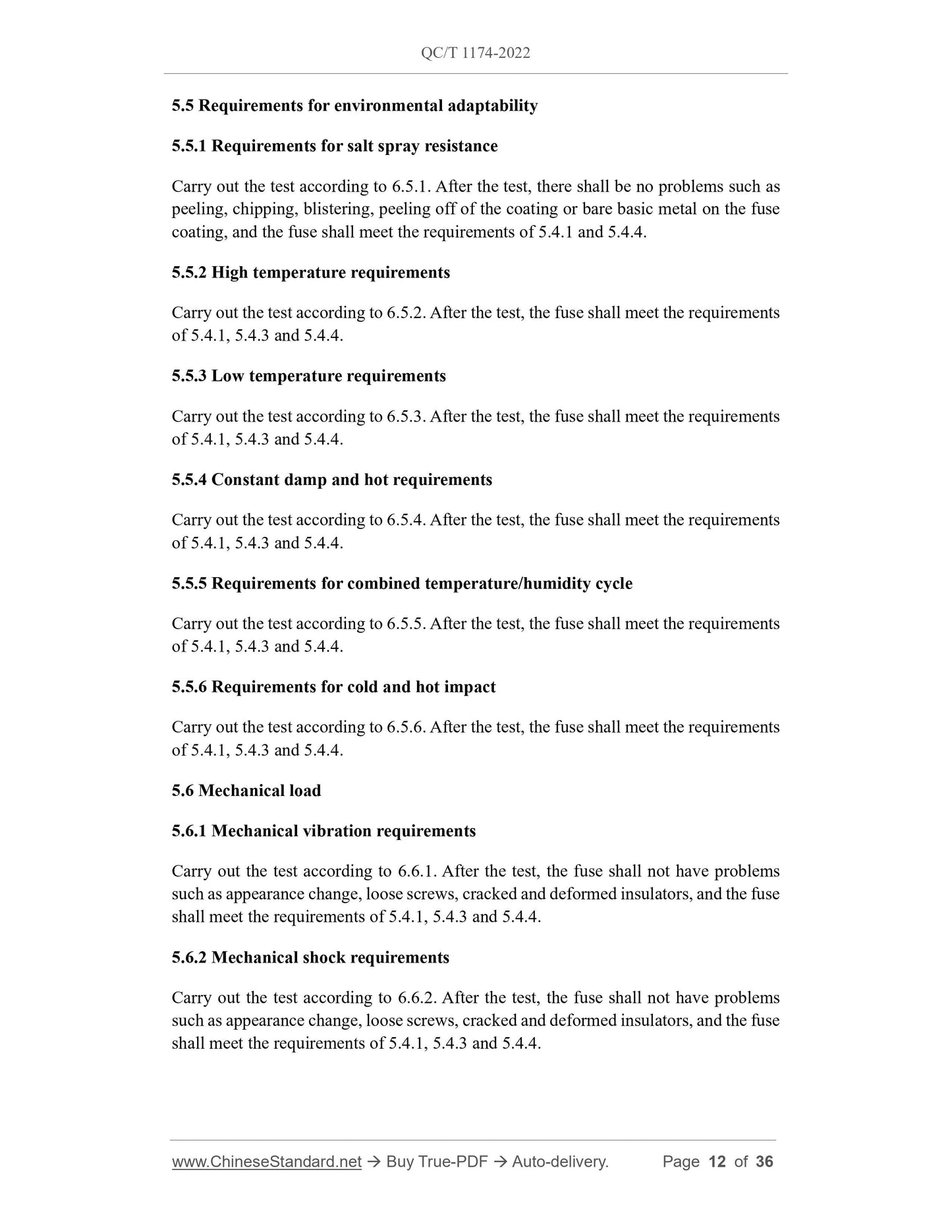1
/
de
12
PayPal, credit cards. Download editable-PDF & invoice in 1 second!
QC/T 1174-2022 English PDF (QCT1174-2022)
QC/T 1174-2022 English PDF (QCT1174-2022)
Prix habituel
$410.00 USD
Prix habituel
Prix promotionnel
$410.00 USD
Prix unitaire
/
par
Frais d'expédition calculés à l'étape de paiement.
Impossible de charger la disponibilité du service de retrait
Delivery: 3 seconds. Download true-PDF + Invoice.
Get QUOTATION in 1-minute: Click QC/T 1174-2022
Historical versions: QC/T 1174-2022
Preview True-PDF (Reload/Scroll if blank)
QC/T 1174-2022: High voltage fuse for electric vehicles
QC/T 1174-2022
QC
AUTOMOBILE INDUSTRY STANDARD
OF THE PEOPLE’S REPUBLIC OF CHINA
ICS 43.020
CCS T 09
High voltage fuse for electric vehicles
ISSUED ON: APRIL 08, 2022
IMPLEMENTED ON: OCTOBER 01, 2022
Issued by: Ministry of Industry and Information Technology of PRC
Table of Contents
Foreword ... 6
1 Scope ... 7
2 Normative references ... 7
3 Terms and definitions ... 7
4 Symbols and abbreviations ... 9
5 Requirements ... 10
6 Test methods ... 13
7 Inspection rules ... 25
Appendix A (Informative) Fuse installation method and installation torque ... 28
Appendix B (Informative) Structure of H-type and J-type fuses ... 29
Appendix C (Informative) Guidelines for application of fuse ... 31
References ... 36
High voltage fuse for electric vehicles
1 Scope
This document specifies the technical requirements, test methods and inspection rules
for high voltage fuse for electric vehicles.
This document applies to high voltage fuse (referred to as fuse) for electric vehicles
with a DC working voltage of 60 V to 1500 V.
This document does not apply to smart fuses and circuit breakers for electric vehicles.
2 Normative references
The following documents, in whole or in part, are normatively referenced in this
document and are indispensable for its application. For dated references, only the
version corresponding to that date is applicable to this document; for undated references,
the latest version (including all amendments) is applicable to this document.
GB/T 2423.18-2012, Environmental testing - Part 2: Test methods - Test Kb: Salt
mist, cyclic (sodium chloride solution)
GB/T 2423.34-2012, Environmental testing - Part 2: Test methods - Test Z/AD:
Composite temperature/humidity cyclic test
GB/T 2423.56-2018, Environmental testing - Part 2: Test methods - Test Fh:
Vibration, broadband random and guidance
GB/T 13539.1-2015, Low-voltage fuses - Part 1: General requirements
GB/T 28046.3-2011, Road vehicles - Environmental conditions and testing for
electrical and electronic equipment - Part 3: Mechanical loads
GB/T 31465.1-2015, Road vehicles - Fuse-link - Part 1: Definitions and general test
requirements
3 Terms and definitions
Terms and definitions determined by GB/T 13539.1-2015 and GB/T 31465.1-2015, as
well as the following, are applicable to this document.
3.1 Fuse
Note 1: Pre-arcing I2t is the integral of I2t within the pre-arcing time of the fuse.
Note 2: Operating I2t is the integral of I2t within the operating time of the fuse.
3.10 Rated current
The current value that is used to identify a fuse, which is measured in accordance with
a prescribed method.
Note: The continuous working current of the fuse should be lower than the rated current,
and the use of derating can be in accordance with Appendix C.
3.11 Rated voltage
The maximum supply voltage applicable to the fuse.
3.12 Prospective current
The current that would flow in a circuit if the fuse is replaced by a conductor of
negligible impedance.
3.13 Operation mode
The operation mode is defined as follows:
a) operation mode 1: the fuse is not connected to the cable or copper bar;
b) operation mode 2: the fuse is connected to the cable or copper bar, but not
energized;
c) operation mode 3: the fuse is connected to the cable or copper bar and energized.
Note: The installation method of the fuse is in accordance with Figure A.1 in the
appendix; the installation torque is in accordance with Table A.1 in the appendix.
4 Symbols and abbreviations
In addition to the symbols mentioned in 3.9, the following symbols also apply to this
document:
I2t: joule integral;
IR: rated current;
RT: room temperature;
UR: rated voltage.
5 Requirements
5.1 Working environment
Unless otherwise specified, the fuse shall be able to work normally in the following
environmental conditions:
a) Temperature: -40 °C ~ 85 °C;
b) Relative humidity: 5% ~ 95%;
c) Atmospheric pressure: 61.6 kPa ~ 106.2 kPa.
5.2 Appearance
The appearance and identification of the fuse shall meet the following requirements:
a) The surface of the enclosure shall be uniform in color, smooth, flat and dry, and
shall be free from obvious scratches, burrs, rust, deformation, cracks and other
defects;
b) Product nameplates, plates, labels or indications shall be correct, complete, clear,
and reliably and permanently attached to the enclosure.
5.3 Dimensions and tolerances
The dimensions and tolerances of the fuse shall meet the requirements of the product
drawings.
5.4 Electrical performance
5.4.1 Requirements for internal resistance
Carry out the test according to 6.4.1, and the relative deviation between the measured
value and the internal resistance value declared by the manufacturer shall not exceed
±10%.
5.4.2 Requirements for temperature rise
Carry out the test according to 6.4.2. The temperature rise value of the fuse terminal
shall not exceed 50 K, and the temperature rise value at the center of the insulator can
be determined through negotiation between the supplier and the buyer. After the test,
the overall fuse shall not have obvious discoloration, the terminal, terminal plating and
label shall not be burnt and peeled off, and the fuse shall meet the requirements of 5.4.1.
5.4.3 Requirements for fusing
5.5 Requirements for environmental adaptability
5.5.1 Requirements for salt spray resistance
Carry out the test according to 6.5.1. After the test, there shall be no problems such as
peeling, chipping, blistering, peeling off of the coating or bare basic metal on the fuse
coating, and the fuse shall meet the requirements of 5.4.1 and 5.4.4.
5.5.2 High temperature requirements
Carry out the test according to 6.5.2. After the test, the fuse shall meet the requirements
of 5.4.1, 5.4.3 and 5.4.4.
5.5.3 Low temperature requirements
Carry out the test according to 6.5.3. After the test, the fuse shall meet the requirements
of 5.4.1, 5.4.3 and 5.4.4.
5.5.4 Constant damp and hot requirements
Carry out the test according to 6.5.4. After the test, the fuse shall meet the requirements
of 5.4.1, 5.4.3 and 5.4.4.
5.5.5 Requirements for combined temperature/humidity cycle
Carry out the test according to 6.5.5. After the test, the fuse shall meet the requirements
of 5.4.1, 5.4.3 and 5.4.4.
5.5.6 Requirements for cold and hot impact
Carry out the test according to 6.5.6. After the test, the fuse shall meet the requirements
of 5.4.1, 5.4.3 and 5.4.4.
5.6 Mechanical load
5.6.1 Mechanical vibration requirements
Carry out the test according to 6.6.1. After the test, the fuse shall not have problems
such as appearance change, loose screws, cracked and deformed insulators, and the fuse
shall meet the requirements of 5.4.1, 5.4.3 and 5.4.4.
5.6.2 Mechanical shock requirements
Carry out the test according to 6.6.2. After the test, the fuse shall not have problems
such as appearance change, loose screws, cracked and deformed insulators, and the fuse
shall meet the requirements of 5.4.1, 5.4.3 and 5.4.4.
6 Test methods
6.1 General conditions of test
6.1.1 Test standard atmospheric conditions
Unless otherwise specified, all tests shall be carried out under the following
environmental conditions:
a) Room temperature: 23 °C ± 5 °C;
b) Relative humidity: 5% ~ 95%;
c) Atmospheric pressure: 61.6 kPa ~ 106.2 kPa.
6.1.2 Test equipment
The instruments, equipment and loading conditions...
Get QUOTATION in 1-minute: Click QC/T 1174-2022
Historical versions: QC/T 1174-2022
Preview True-PDF (Reload/Scroll if blank)
QC/T 1174-2022: High voltage fuse for electric vehicles
QC/T 1174-2022
QC
AUTOMOBILE INDUSTRY STANDARD
OF THE PEOPLE’S REPUBLIC OF CHINA
ICS 43.020
CCS T 09
High voltage fuse for electric vehicles
ISSUED ON: APRIL 08, 2022
IMPLEMENTED ON: OCTOBER 01, 2022
Issued by: Ministry of Industry and Information Technology of PRC
Table of Contents
Foreword ... 6
1 Scope ... 7
2 Normative references ... 7
3 Terms and definitions ... 7
4 Symbols and abbreviations ... 9
5 Requirements ... 10
6 Test methods ... 13
7 Inspection rules ... 25
Appendix A (Informative) Fuse installation method and installation torque ... 28
Appendix B (Informative) Structure of H-type and J-type fuses ... 29
Appendix C (Informative) Guidelines for application of fuse ... 31
References ... 36
High voltage fuse for electric vehicles
1 Scope
This document specifies the technical requirements, test methods and inspection rules
for high voltage fuse for electric vehicles.
This document applies to high voltage fuse (referred to as fuse) for electric vehicles
with a DC working voltage of 60 V to 1500 V.
This document does not apply to smart fuses and circuit breakers for electric vehicles.
2 Normative references
The following documents, in whole or in part, are normatively referenced in this
document and are indispensable for its application. For dated references, only the
version corresponding to that date is applicable to this document; for undated references,
the latest version (including all amendments) is applicable to this document.
GB/T 2423.18-2012, Environmental testing - Part 2: Test methods - Test Kb: Salt
mist, cyclic (sodium chloride solution)
GB/T 2423.34-2012, Environmental testing - Part 2: Test methods - Test Z/AD:
Composite temperature/humidity cyclic test
GB/T 2423.56-2018, Environmental testing - Part 2: Test methods - Test Fh:
Vibration, broadband random and guidance
GB/T 13539.1-2015, Low-voltage fuses - Part 1: General requirements
GB/T 28046.3-2011, Road vehicles - Environmental conditions and testing for
electrical and electronic equipment - Part 3: Mechanical loads
GB/T 31465.1-2015, Road vehicles - Fuse-link - Part 1: Definitions and general test
requirements
3 Terms and definitions
Terms and definitions determined by GB/T 13539.1-2015 and GB/T 31465.1-2015, as
well as the following, are applicable to this document.
3.1 Fuse
Note 1: Pre-arcing I2t is the integral of I2t within the pre-arcing time of the fuse.
Note 2: Operating I2t is the integral of I2t within the operating time of the fuse.
3.10 Rated current
The current value that is used to identify a fuse, which is measured in accordance with
a prescribed method.
Note: The continuous working current of the fuse should be lower than the rated current,
and the use of derating can be in accordance with Appendix C.
3.11 Rated voltage
The maximum supply voltage applicable to the fuse.
3.12 Prospective current
The current that would flow in a circuit if the fuse is replaced by a conductor of
negligible impedance.
3.13 Operation mode
The operation mode is defined as follows:
a) operation mode 1: the fuse is not connected to the cable or copper bar;
b) operation mode 2: the fuse is connected to the cable or copper bar, but not
energized;
c) operation mode 3: the fuse is connected to the cable or copper bar and energized.
Note: The installation method of the fuse is in accordance with Figure A.1 in the
appendix; the installation torque is in accordance with Table A.1 in the appendix.
4 Symbols and abbreviations
In addition to the symbols mentioned in 3.9, the following symbols also apply to this
document:
I2t: joule integral;
IR: rated current;
RT: room temperature;
UR: rated voltage.
5 Requirements
5.1 Working environment
Unless otherwise specified, the fuse shall be able to work normally in the following
environmental conditions:
a) Temperature: -40 °C ~ 85 °C;
b) Relative humidity: 5% ~ 95%;
c) Atmospheric pressure: 61.6 kPa ~ 106.2 kPa.
5.2 Appearance
The appearance and identification of the fuse shall meet the following requirements:
a) The surface of the enclosure shall be uniform in color, smooth, flat and dry, and
shall be free from obvious scratches, burrs, rust, deformation, cracks and other
defects;
b) Product nameplates, plates, labels or indications shall be correct, complete, clear,
and reliably and permanently attached to the enclosure.
5.3 Dimensions and tolerances
The dimensions and tolerances of the fuse shall meet the requirements of the product
drawings.
5.4 Electrical performance
5.4.1 Requirements for internal resistance
Carry out the test according to 6.4.1, and the relative deviation between the measured
value and the internal resistance value declared by the manufacturer shall not exceed
±10%.
5.4.2 Requirements for temperature rise
Carry out the test according to 6.4.2. The temperature rise value of the fuse terminal
shall not exceed 50 K, and the temperature rise value at the center of the insulator can
be determined through negotiation between the supplier and the buyer. After the test,
the overall fuse shall not have obvious discoloration, the terminal, terminal plating and
label shall not be burnt and peeled off, and the fuse shall meet the requirements of 5.4.1.
5.4.3 Requirements for fusing
5.5 Requirements for environmental adaptability
5.5.1 Requirements for salt spray resistance
Carry out the test according to 6.5.1. After the test, there shall be no problems such as
peeling, chipping, blistering, peeling off of the coating or bare basic metal on the fuse
coating, and the fuse shall meet the requirements of 5.4.1 and 5.4.4.
5.5.2 High temperature requirements
Carry out the test according to 6.5.2. After the test, the fuse shall meet the requirements
of 5.4.1, 5.4.3 and 5.4.4.
5.5.3 Low temperature requirements
Carry out the test according to 6.5.3. After the test, the fuse shall meet the requirements
of 5.4.1, 5.4.3 and 5.4.4.
5.5.4 Constant damp and hot requirements
Carry out the test according to 6.5.4. After the test, the fuse shall meet the requirements
of 5.4.1, 5.4.3 and 5.4.4.
5.5.5 Requirements for combined temperature/humidity cycle
Carry out the test according to 6.5.5. After the test, the fuse shall meet the requirements
of 5.4.1, 5.4.3 and 5.4.4.
5.5.6 Requirements for cold and hot impact
Carry out the test according to 6.5.6. After the test, the fuse shall meet the requirements
of 5.4.1, 5.4.3 and 5.4.4.
5.6 Mechanical load
5.6.1 Mechanical vibration requirements
Carry out the test according to 6.6.1. After the test, the fuse shall not have problems
such as appearance change, loose screws, cracked and deformed insulators, and the fuse
shall meet the requirements of 5.4.1, 5.4.3 and 5.4.4.
5.6.2 Mechanical shock requirements
Carry out the test according to 6.6.2. After the test, the fuse shall not have problems
such as appearance change, loose screws, cracked and deformed insulators, and the fuse
shall meet the requirements of 5.4.1, 5.4.3 and 5.4.4.
6 Test methods
6.1 General conditions of test
6.1.1 Test standard atmospheric conditions
Unless otherwise specified, all tests shall be carried out under the following
environmental conditions:
a) Room temperature: 23 °C ± 5 °C;
b) Relative humidity: 5% ~ 95%;
c) Atmospheric pressure: 61.6 kPa ~ 106.2 kPa.
6.1.2 Test equipment
The instruments, equipment and loading conditions...
Share
